While I prepare to relocate (I’m moving next week!), I was fortunate to have the help of James Duthie, a serial guest blogger from Online Marketing Banter, a blog on social media, marketing, and more.? You can subscribe to more of his ramblings here.
A few weeks ago I wrote a post over at SEO Scoop comparing the quality of search engine traffic against social media traffic. The aim of my little experiment was to test the assumption that search traffic was of a higher quality than social media traffic. And as most would have guessed, the mighty engines prevailed as the superior source of traffic. Many people found the research interesting, but a number of people commented that the social networks probably shouldn’t be grouped together. Some are built for the masses whereas others have tightly defined niche audiences. So the question arose – was social media traffic misrepresented by grouping traffic from all networks together? Is traffic from highly targeted niche networks better than traffic from generic networks? (Hat tip to Gab for posing that question to me.) Let’s find out.
To help me in this quest for the truth I enlisted the help of a couple of my fellow online marketing and SEO buddies. Gab Goldenberg and Steven Bradley came to the party and donated their site stats for analysis, thereby providing three data points for observable trends (along with my own site). Three cheers for them!
Let the Social Media Traffic Quality Analysis Begin
In order to answer the question of whether niche social media drives higher quality traffic, two social networks were chosen for analysis — one generic and one niche. Let’s get ready to rumble…
- Generic network: StumbleUpon: In the blue corner we have Stumbleupon – one of the largest social bookmarking sites on the web. While some argue that StumbleUpon traffic is targeted, the broad nature of content categories and misclassification of content means this is rarely the case. As such, it has been selected as the generic social network of choice.
- Niche network: Sphinn: In the red corner we have Sphinn – a social news network dedicated purely to online marketing news and discussion. All three sites at the centerr of this analysis sit within the online marketing and search industry. Subsequently, Sphinn is perhaps the most relevant niche social network on the web.
In order to provide an assessment of the quality of traffic driven by each network, four site metrics were analyzed:
- Average page views
- Time on site
- Bounce rate
- Percentage of returning visitors
Let’s see what the figures reveal.
Round 1: Average Page Views
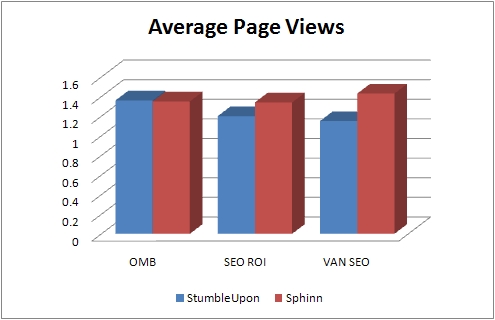
Average page views is the first indicator of traffic quality, demonstrating the propensity of a user to explore a site beyond the initial click. Logic says that the more pages a user views, the higher their level of engagement with the site. Unfortunately for StumbleUpon, users rarely seem to explore beyond the initial page, with the average page views hovering just above 1:
- Online Marketing Banter — 1.36 page views
- SEO ROI — 1.2 page views
- Van SEO Design — 1.15 page views
While a parity in page views exists between social networks for Online Marketing Banter, both SEO ROI and Van SEO Design experience higher engagement levels from Sphinn members. It’s likely that the technical nature of content on SEO ROI and Van SEO Design rarely hits the target audience in StumbleUpon. Indeed the most appropriate categories of “Marketing” and “Science/Tech” are extremely broad and unlikely to deliver traffic with an interest in SEO. Conversely, with a slightly more generic subject matter (and the occasional gag post), Online Marketing Banter seems to be a little more popular with Stumblers.
Nevertheless, Sphinn takes out round 1 based on the enhanced engagement levels seen in 2 of the 3 blogs.
Round 2 – Time on Site
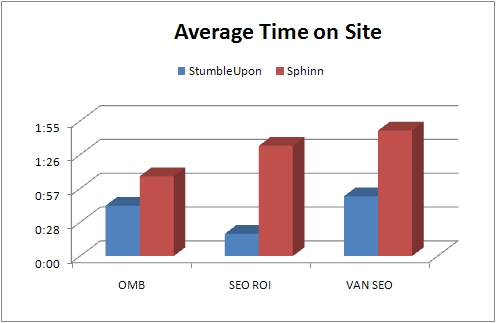
The average time spent on a site is a secondary measure of reader engagement. Naturally, the more time a user spends on a site, the higher the level of perceived engagement. And the data provides a very strong indication that users from niche networks spends far more time consuming content. In fact, the additional time spent on each site ranged from 25 seconds up to 72 seconds!
The browsing intent of the audience is likely to be a significant factor in the disparity in engagement levels. Most Stumblers are casual browsers by nature who use the network to discover new and interesting content. Professional content probably isn’t a priority. On the other hand, Sphinn is a professional network dedicated to industry news. Users are actively seeking information that will enhance their professional knowledge. So it comes as no surprise to learn that they are more committed to information digestion.
Subsequently, Sphinn knocks StumbleUpon to the canvas and takes out round 2.
Round 3 – Bounce Rate
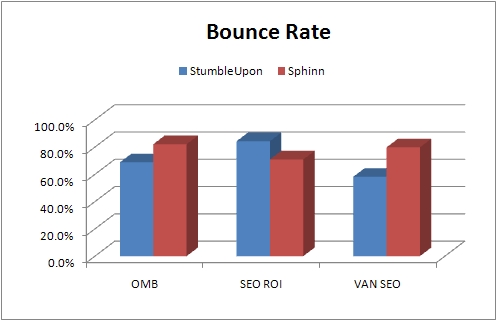
Bounce rate is the third and final measure of reader engagement. Bounce rate measures the proportion of users who leave a site without visiting a second page, a common trait amongst social media users. At first glance it appears that StumbleUpon holds the upper hand, with a lower bounce reported on both Online Marketing Banter and Van SEO Design.
However, bounce rate data for StumbleUpon is misleading. The StumbleUpon toolbar often pre-fetches a page before displaying it to a Stumbler in order to help it load faster. When this process occurs two page views are counted instead of one, thereby lowering the bounce rate. This trend is discussed further by Jamie Harrop and Rebecca Murphey. Unfortunately, this anomaly renders StumbleUpon’s bounce rate data invalid. After all, how could Van SEO Design maintain a bounce rate of just 58.2% in StumbleUpon when the average number of page views from that source is just 1.15…?
Unfortunately, round 3 has been tainted with StumbleUpon attempting to bite off Sphinn’s ear. No clear winner can be declared.
Round 4 – Percentage of New Visitors
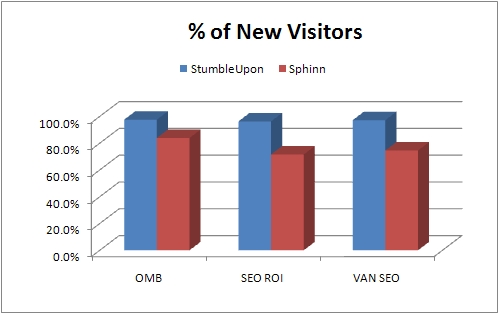
The percentage of new visitors provides a basic metric for user loyalty. While not a perfect measure, it gives an indication of the proportion of visitors who return to the site after first discovering it. And the evidence is fairly damning for StumbleUpon, with less than 5% of visitors ever returning to a site they discovered:
- Online Marketing Banter — 97.6% new visitors
- SEO ROI — 96.5% new visitors
- Van SEO Design — 97.2% new visitors
While Sphinn itself doesn’t generate outstanding loyalty from members, its users are significantly more likely to return to a site they found. However, it should be noted that the smaller pool of sites submitted to Sphinn means there is an increased likelihood that users will re-encounter a previous site.
Despite this, Sphinn clearly wins the fourth and final round.
The Verdict
The judges are unanimous and the decision is in: niche social networks do indeed have the ability to drive higher quality traffic than generic networks. Members of niche networks view more pages, spend more time on a site and come back more often. And if this post isn’t proof enough for you, check out Steven’s post relating to the quality of forum traffic, which often have even tighter knit communities than Sphinn. Steven reports that the average user from one niche forum stays for more than 7 and 1/2 minutes! Which is nothing compared to a second forum where visitors spend over 16 minutes on the site.
If your social media traffic is unengaged, perhaps you need to reconsider the networks you’re participating in.
Special Thanks
A special thanks must go out to Gab Goldenberg of SEO ROI and business card design software, along with Steven Bradley of Van SEO Design. Their valuable input allowed real insights to be made into the topic. Thank you to both of you.

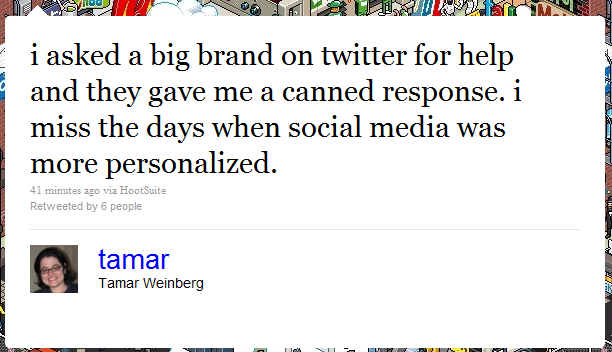
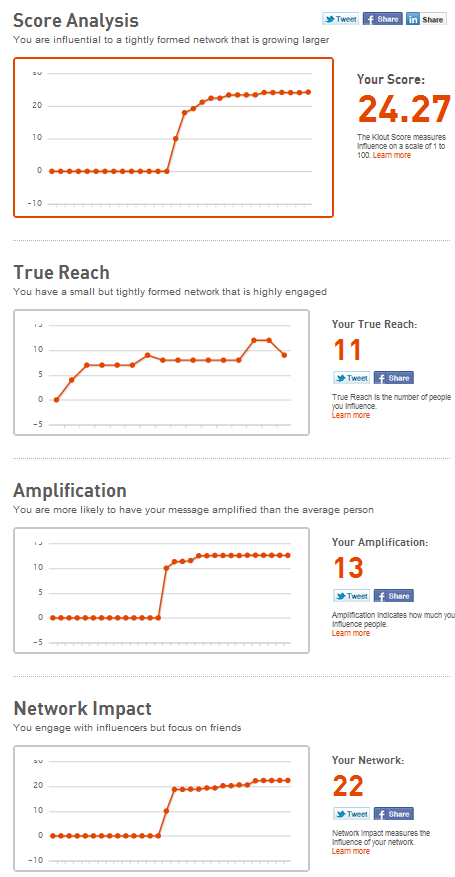
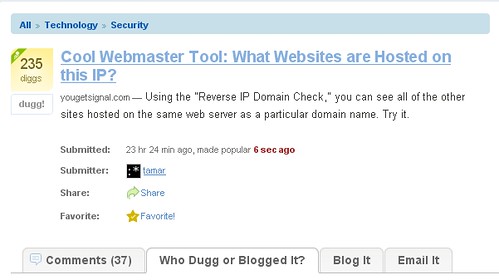

It all depends on the site and the content though. I have a few different blogs, one being a humor blog. My humor blog does really well with stumble upon and other social media traffic including social networking referrals, the average visitor spends more time on the page and visits more pages than search engine traffic.
It is all relative to the content and the site. Sure tech blogs and social media blogs are probably going to do better with search engines. Other topics though maybe not so much. It is about finding the right blend and the strengths of your site.
It’s the same basic conflict that always exists in marketing: shotgun or sniper rifle?
And as Kevin points out, it really depends on your goals. Some clients are happy with a handful of really solid leads. Others want massive brand exposure.
FWIW, I totally agree that forums are the forgotten and often under-appreciated social media, so I’m now off to Steven’s post to check that out.
Good research, as always! 🙂
Great post Tamar.
One parameter you didn’t mention of course is the number of visits. While a popular story on a general social network brings you 1000s of visits, a popular story on a niched network will bring you tens to hundreds the most.
So, the question is actually what you really prefer – quality or quantity, assuming that the amount of time you can dedicate to promotion is given.
James, great post. Funny how giving someone else your data will teach you things about your own visitors. The time on site graph was an eye opener!
@ Tal – That’s a common misconception. Usually Su sends 200-300 visitors and dies off. It’s only the biggest of the social media powerhouses that get 1000s of visitors from generic networks. Besides, even in the hypothesis that you get say 1000 visitors from SU – subtract the bounces and you’re left with 100-200. The amount of visitors an average Sphinn frontpage sends. Note also that it’s easier to get sphinn frontpages…
Also, this post was written by James Duthie, not Tamar.
Well, I think it depends, Gab. My SU account is relatively strong and there are a few more than 200-300 visitors. Granted, that doesn’t eliminate the bounce rate issue, but it still gets more than 200 visitors — even for my “weaker” submissions.
So as for the “ease” of getting the content onto the Sphinn frontpage, how come this isn’t even halfway there yet? 😉 http://sphinn.com/story/68588
@ Kevin/Kat – Ultimately I think there’s room for both niche and generic networks in a social media engagement plan. I know I concentrate my social media efforts on the 2 networks listed in the post – SU for the masses and Sphinn for the targeted traffic. Both have their benefits and limitations, and goals should be set based on these.
@ Tal/Gab – It’s true each network delivers a different weight of numbers. SU undoubtedly delivers more traffic, but Gab’s point about the amount of real visitors after subtracting bounces is a very good one. Again, it boils down to what your goal is (sheer numbers or targeted eyeballs).
@ Tamar – it’s getting there slowly in Sphinn – just made the most sphunn list on the side bar (for new posts). Hopefully it’ll get there tomorrow.
Ring-side seats! This is the type of analysis great posts are made of!
Sphinn story sphunn.
Stumbled this and wonder why SU assigned the “science” tag by default. Oh, because you have charts and data!
Keep more comparisons like this coming…
Thanks Dana 🙂
As far as the “science” designation is concerned, for whatever reason, StumbleUpon clumps “technology” into “science.” Typically, I change the tags by adding the 5 additional tags of my own (to target the message more appropriately), but I’m not sure how widely this is practiced. If more people notated that it should be tagged as “technology,” the likelihood that it would be changed would increase, I believe.
Tamar, I always change the tags, too. Most marketing/SEO/SMM posts are tagged as “internet” for me. However, SU definitely saw this post as more sci/tech than Internet.
I, too, have been adding tags, “search,” “seo,” etc. and trying to be consistent. Do you know where we can see a list of SU tags?
Nope, I don’t think that list is available. If I recall, I sent that request to StumbleUpon to include months ago, and they said no such feature is available. 🙁
Well, StumbleUpon knows you now due to recent “conversations” with them, so maybe you can be our squeaky wheel and get some tag grease!
THis seems like intuitive common sense but it’s always good to have the numbers and graphs of actual data to back it up.
One further question is do these visitors convert? Do they take the action you want them to like signup for your rss, email subscribe or buy from you?
I believe it’s definitely different for each site and depends on the content of each site. My friends who have popular news, political, science sites etc… see much better numbers and subscribers from sites such as Sphinn and even Digg and so on . Even with the same amount of friends they don’t see nearly the number of visitor to subscriber conversions. Sometimes it has to also do with other factors such as the content and layout of each site. Visitors will not come back if your site is full of ads or the content isn’t top notch. So in my opinion any visitors are good visitors, the question each blogger should ask themselves is:
what’s gonna keep them coming back and wanting more?
If anyone finds the answer to that one please let me know. Lol
Have a wonderful wknd everyone and God Bless.
SU traffic and Search Engine Traffic can never be compared as search engine traffic is highly funneled out. I mean a user is already thinking of what he is looking for (rather than some random browsing) and has very high chances of conversions (in terms of anything whether it is subscriptions or sales).
It would be interesting to see ROI and conversion rates for SU traffic specially from people buying SU traffic.
By the way, you have got a stalker in twitter 🙂
James/Tamar very interesting comparison I was wondering if you also compared or gathered data on the GEO-locations of the traffic from Stumbleupon & Sphinn. Would Be interesting to see and filter out areas for example US and Non-US traffic.
I thought Sphinn would been even more likely to be peer traffic from the same niche then convertible traffic
As with any debate the word “depends” always comes up since each persons traffic is of different value to that individual person. So for a person marketing a site that has a braod niche social would be better but if a very closed narrow niche then The Mighty Engine will prevail
so I guess “It depends”
I think there are way too many variables here to come to a conclusion. We would need a test where identical articles are stumbled and sphinned and see the stats that way. Nonetheless, this post was very useful and thanks for taking the time to aggregate the data.
Much better to be a general site, but that means you have to be early and establish the category. If you’re late and someone else has already captured the general audience, then it’s best to be focusing on a niche strategy. That’ the way we see it from the venture capital investor’s standpoint.
Sphinn really drives great traffic…
Nice post Tamar…
I have a site ownmine.com but the social media thing is not working properly in this case, the only traffic I get is from the search engine or direct visitors…
Very nice post.
Excellent post.With so many social news sites to choose from I would go with the niche sites.The traffic you get will be more targeted that way.
Well said! You have excellent writing skills! Bookmarked!
Personally my CTR for ads is bad on all traffic generated by social media sites, although long-term I notice it does build links to good quality content.